Introduction and History

Blue Heeler, which is commonly known as the Australian Cattle Dog. This breed was originated in Australia in 19th Century having characteristics of a sturdy and resilient dog. This breed is a cross actually between the native Australian Dingo and British herding dogs. Developed by Australian settlers. The settlers may be looking for a dog which is capable of herding cattle over long distances in the harsh environment of Australia and hard-working capabilities as well.
The settlers were successful as the result was a robust and agile breed. This becomes an intelligence, endurance, and strong herding instincts dogs. The dog breed named after its distinctive blue mottled coat color, and speckling or ticking. This coat provides protection from the sun and allowed it to blend with in the cattle while herding.
A herding cattle dog, soon proved as an adaptable working dog. The dog, excelled driving cattle over vast distances, adopting harsh conditions with outstanding resilience. People were choosing this breed beyond herding with the time, as a guard dog, companion, and even in roles such as search and rescue or competitive obedience owing to breed's intelligence and versatility.
Blue Heeler’s Physical Characteristics:
In today’s time, is a popular breed both in Australia and around the globe, having all the values such as loyalty, work ethic, and devotion to a family. Its rich history has made it with good reputation as a skilled working dog, making it a favorite among farmers, ranchers, and dog enthusiasts.
Blue Heeler breed is a medium-sized dog. For example adult males typically stand between 18 to 20 inches (46 to 51 cm) tall, while females are slightly smaller. Their weight ranges from 35 to 50 pounds only. The breed’s coat is short, dense, and weather-resistant. The dominant color is blue, which ranges from a dark slate to a lighter blue-gray. In distinctive appearance, they often have black and blue speckling or mottling throughout the coat. Some individuals may have tan markings on their legs, chest, and face.
The dog / Healers are exceptionally intelligent dogs; this makes it one of among the smartest breeds. They have a keen ability to learn and excel in obedience training, problem-solving tasks, and including various doggish sports.
Appearance and Energy Level:
As a working/herding breed, Blue heelers are abundant in energy and stamina. They bloom on physical and mental activities and require regular exercise to stay happy and healthy. insufficient outlets for their energy enhancing, may become cause exhibition of some undesirable behaviors.
It was purely Bred for herding cattle but groomed to have a strong instinct to work and loyalty. They are driven, focused, and determined. That’s why, the dog form deep bonds with keeping families and are fiercely loyal & protective. They are known as a devoted companion.
They also possess innate herding instincts; naturally alert and attentive. They can quickly notice changes in their environment and are often wary of strangers which makes them effective watchdogs. They also have an independent streak while affectionate and devoted. They are pretty self-confident dogs but they still need training from the start.
This Canine are capable of excelling in various roles. This dog has versatility in nature and characteristics as beyond herding heritage. For Example, active household where they can participate in different range of activities and tasks, using their intelligence, athleticism, and strong work ethic can make them more agile.
Here are some examples to show that how they are adaptable for even modern-day roles beyond traditional hardening. As, it’s nature combines intelligence, high energy, loyalty, and versatility, making it a suitable companion for individual or family.
Search and Rescue Operations: Owing to their intelligence, agility, and acute sense of smell, they are often trained and used in various search and rescue operations. Such as operations for missing persons in any sort of area which may include wilderness areas, mountains, and urban environment.
Agility: They can easily navigate obstacle paths with precision and speed, this breed are well-suited for competitive agility trials. They have ability to respond to commands quickly and efficiently.
Obedience: This breed are keen in learning and trainings. They perform well in obedience competitions. They excel in tasks such as heeling, retrieving, and following commands, demonstrating their focus, discipline, and willingness to work closely with their handlers
Care & Maintenance Requirements:
This breed cross-breed belongs to a have high energy levels breed. That’s why they require exercises on regular basis to be fit physically and mentally stimulated. Daily exercise is crucial for such a breed which is produced for herding. It could prevent boredom and ensure well-being of a dog. Recommended activities are: Large distance of hikes. The dog are quite fond of exploring their environment which is a good source to burn off energy.
Agility training, are a good way to make benefits bond with this breed. Agility courses and classes helps their energy into constructive activities.
Herding activities, are very useful as dog obviously enjoy participating in herding trials or activities designed to simulate their natural instincts.
- Grooming Requirements: The dog are dogs with short, dense coat that needs minimal dressing. Brushing helps remove loose hair and dirt, while natural oils are also good to keep their coat healthy and shiny. Additionally, nail cutting, proper and regular doctor visits are necessary to keep the dog in good health.
- Health Considerations
Common health considerations for a this breed are there as for every dog, although it is a good and strong breed
- Australian Cattle Dog hereditary ataxia (ACDHA): A neurological illness that can affects coordination and movement.
- Hip dysplasia: A inherited issue that directly affects the hip joints, cause pain and mobility problem.
- Deafness: White on their heads or bodies may be at a higher risk of congenital deafness.
Solution: Regular check-ups by veterinary, vaccinations, and good care are vital for maintaining your breed's health and detecting any potential issues early.
Nutrition and Feeding Guidelines:
The dog flourish on a balanced diet personalized to their age, size, activity level, and health status. A High-quality dog food articulated for active breeds is generally fit for the dog. Be careful, that the food contains essential nutrients, protein, fats, carbohydrates, vitamins, and minerals. Division of their daily food intake into two or three necessary meals to prevent digestive issues and maintain energy levels. Monitoring breed's weight is also crucial this will make you knowledgeable about hot to adjust their portion sizes accordingly to prevent obesity. Always provide access to fresh water and consult with your veterinarian for personalized feeding recommendations. Learn more Dogs
